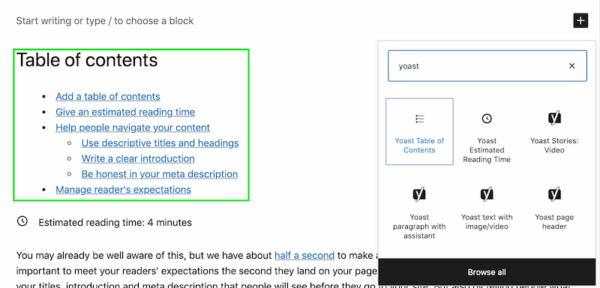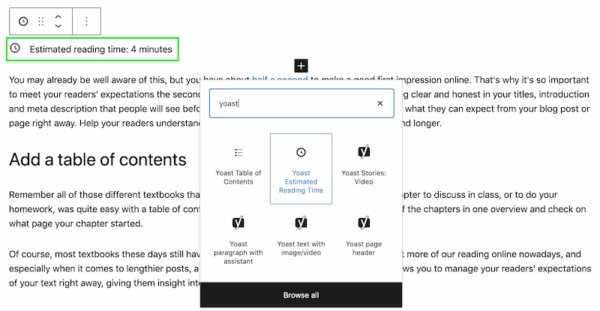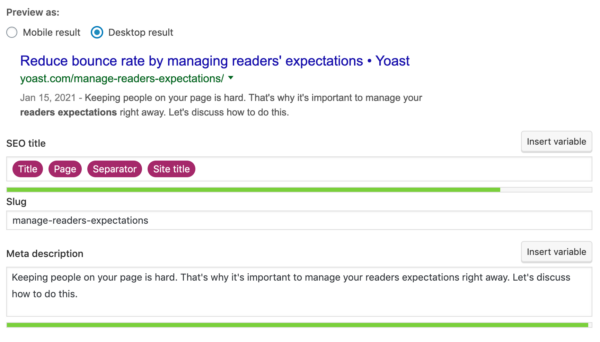Grabbing the attention of people online is hard. But keeping that attention is way harder. In fact, it takes most site visitors less than a second to form an opinion about your page. That’s all the time they need to decide if they’re going to stay or not. So having a clear message that’s easy to grasp is essential. You need to show people what your post is about, and why they should stay a bit longer than that first second. Managing readers’ expectations right away can convince them of the usefulness of your post and might even reduce the bounce rate at the same time!
Estimated reading time: 9 minutes
You may already be well aware of this, but you have about half a second to make a good first impression online. That’s why it’s so important to meet your readers’ expectations the second they land on your page.
You can do this by being clear and honest in your titles, introduction, and meta description that people will see before they go to your site. But also by telling people what they can expect from your blog post or page right away. Help your readers understand what your text is about to reduce the bounce rate of your page and keep them hanging around longer.
Of course, there are many more things you can do to prevent people from bouncing back to Google, like improving page speed and page experience. But here, we’ll focus on some easy steps to optimize your content and make people stay!
Add a table of contents
Remember all of those different textbooks that you had to read in school? Finding the right chapter to discuss in class, or to do your homework, was quite easy with a table of contents at the start of the book. You could find all of the chapters in one overview and simply check on what page your chapter started.
Of course, most textbooks these days still have these. But what about online texts? We do a lot more of our reading online, and especially when it comes to lengthier posts, a table of contents would be quite handy. So why not add them to your online posts? This allows you to manage your readers’ expectations of your text right away, giving them insight into the topics you’ll discuss.
Meet our Table of Contents block
Did you notice that this post has a table of contents? This one was created with the Yoast Table of contents block, which automatically takes all of your (sub)headings and creates a table of contents with it.

To guide readers to the right paragraphs, this Table of contents block creates hyperlinks for every heading in your text. People can just click this link in the table of contents and go to that part of your text. Another great thing about these hyperlinks is that you can use them to link to these parts of your text on other pages as well! Helping you direct users to the right information right away. And if there’s a (sub)heading you want to leave out, you can do so by clicking on this heading in the editor and removing its HTML anchor under the tab Advanced.
Give an estimated reading time
Another thing you may have noticed is that we gave an estimated reading time at the beginning of this post. This is a great way to show readers how much time it will take to read the entire article. Of course, some people will directly scroll or click through to the part they’re interested in, but giving an estimated reading time is great for site visitors who intend to read your entire post. Especially when you have some longer articles on your site, this can really help manage your reader’s expectations.
Meet our Estimated Reading Time block
Of course, you can simply read your text and make an estimation of how much time people will need to read it, but there’s a faster (and more secure) way. Which is using the Estimated Reading Time block in Yoast SEO Premium.

When you add this block to your content, it will automatically calculate and display the estimated reading time based on the length of your article. You can safely add it any time during your writing, as this block will automatically update the estimated reading time. Even if you add some content at a later moment, the Estimated Reading Time block will always give an up-to-date insight into the length of your article. Another great tool to manage the expectations of your readers!
Help people navigate your content
One of the ways your readers will determine how relevant your page is to them is by scanning the title, headings and introduction. Even before they land on your page, your meta description can also tell them what your page is about. So make sure to manage your readers’ expectations by being clear and honest in these elements of your page.
Use descriptive titles and headings
The title of your page needs to sum up its content with just a few words. We realize that this is a lot to ask and can sometimes even feel near to impossible. But try to take on your reader’s point of view who just wants to know if this page will contain the information they’re looking for. What is the main subject of your page and what question are you answering? Determining this will help you come up with a descriptive and great page title that gives readers an idea of what they can expect.
Also be descriptive in your headings. Of course, it’s always great to use a catchy title or headings that will make readers curious about what they’re going to read. But don’t be too cryptic and try to still keep them descriptive of your page’s content. This will help your reader understand what topics you will discuss on your page. It’s important to be thoughtful of how you use headings on your site.
The SEO analysis in Yoast SEO also gives you feedback on your title and headings. This helps you keep them focused on the main topic of your text, making sure that readers instantly know what that part of your text is about. Using headings to boost the readability of your text this way helps you manage the expectations of your readers.
Write a clear introduction
When landing on a new page, people often have a quick look at the first few lines of text to get an idea of its content. We call these first few lines of text the introduction. The introduction gives you a bit more room to elaborate on what your page is about and what different topics you will discuss. Or perhaps what products people will find on this page. Do make sure to keep it short, as a long introduction can give readers the feeling that they have lots and lots of reading ahead.
Yoast SEO also gives you feedback on the introduction of your page, making sure you’re using the main topic of your text in it. This may seem a bit straight-forward, but we can tell you from experience that people tend to forget using their focus keyphrase in the introduction of a page.
Want to learn how to write a great introduction or the best SEO copy in general? In our SEO copywriting training you’ll learn how to write excellent copy for both your audience and search engines (and you’ll get access to our Premium plugin and other courses now too!)
Be honest in your meta description
The meta description is the piece of text that accompanies your page title and URL in the search results when search engines show your page in the results. And yes, your meta description should make people want to click through to your site. But being honest about what you can offer them is more important. You don’t want people leaving right away, and you want to make sure the right people land on your page. So make sure that your meta description is catchy, but also explains to people what they’ll find on your page. Managing the expectations of your readers will help you reel in the right people that actually want to visit your site.
The Yoast SEO plugin allows you to check and make changes to your meta description by showing you an example of your Google preview:

Giving Google a suggestion for your meta description will help increase your visibility in the search results and make sure the right people click through to your page. So make sure to add an honest meta description and don’t leave it to chance!
Make sure to meet reader’s expectations
In this post, we discussed the importance of managing expectations to prevent people from leaving right away. By adding a table of contents, an estimated reading time and a descriptive title. But also, by writing a clear meta description and introduction to get and keep them on your page. Don’t feel like you have to use all of them on all of your pages. But be thoughtful of meeting the expectations of your readers and the elements that can help you do that.
One thing we haven’t discussed is site speed. As a slow site can also be a reason for people leaving right away, we would recommend working on your site speed to reduce the bounce rate of your pages. But before you dive into the next article, we’d love to hear if this article met your expectations as a reader. Let us know in the comments!
Read more: Improving site speed: Tools and suggestions »
The post Manage your readers’ expectations to reduce the bounce rate of your post appeared first on Yoast.
